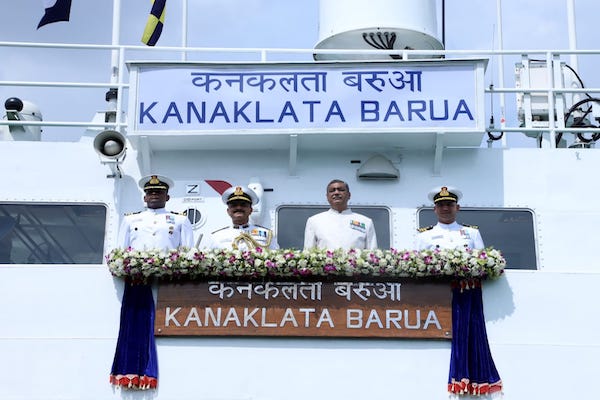Context
- A Fast Patrol Vessel (FPV) named ICGS Kanaklata Barua was commissioned in the Indian Coast Guard on Wednesday, in Kolkata. It is named after a teenage freedom fighter who was shot dead in Assam during the Quit India Movement.

What is the ship?
- It is the fifth and last in a series of FPVs built by Garden Reach Shipbuilders and Engineers (GRSE) Ltd.
- The other four are ICGS Priyadarshini (named after Indira Gandhi), ICGS Annie Besant, ICGS Kamala Devi (after Kamala Devi Chattopadhyay), and ICGS Amrit Kaur.
- These FPVs are upgraded versions of the inshore patrol vessels with a modified form of the hull and can achieve a speed of 34 knots. Such vessels have also been delivered to Indian Navy by GRSE.
- In the Coast Guard these FPVs and their earlier versions belong to the Rajashree class of patrol vessels.
- The previous versions were named ICGS Rajashree, Rajtanag, Rajkiran, Rajkamal, Rajdoot, Rajveer etc; the modified versions are named after freedom fighters.
- These are suited for patrolling, maritime surveillance, anti-smuggling, anti-poaching operations and also for fishery protection, and rescue and search missions.
- These FPVs are medium-range surface vessels with a length of around 50 m, and a displacement of over 300 tonnes.
Who was Kanaklata Barua, after whom it is named?
- One of the youngest martyrs of the Quit India Movement, Kanaklata Barua has iconic status in Assam.
- Kanaklata Barua, then 17, led the Mukti Bahini, a procession of freedom fighters to unfurl the Tricolour at Gohpur police station on September 20, 1942.
- When police did not let them move forward, an altercation led to firing, killing Barua at the head of the procession.
- “She had joined the Mrityu Bahini just two days before the incident.
- Another woman volunteer behind her — Mukunda Kakoty — came and held the flag, and she, too, was shot.
- The fact that she was a young girl — that captured the national imagination of the time.
- It was also a time where you saw a lot of women coming to the fore, leading processions, patriotic fervour was at its peak — and Kanaklata was a product of this time.
- Today, there are schools named after her, there are two statues, there is a ship. While we see her as an icon now, people in her village hated her then — she was a rebel, who questioned patriarchy.
Source: Indian Express
For More History Current Affairs: Click Here
